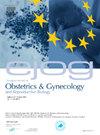Six versus twelve hours of intrauterine balloons placement for cervical ripening: A systematic review and meta-analysis
IF 2.1
4区 医学
Q2 OBSTETRICS & GYNECOLOGY
European journal of obstetrics, gynecology, and reproductive biology
Pub Date : 2025-03-04
DOI:10.1016/j.ejogrb.2025.03.007
引用次数: 0
Abstract
Objective
To assess the efficacy of reducing the duration of intrauterine balloons placement from 12 h to 6 h for labor induction, specifically in terms of reducing the time from balloon placement to delivery and the rate of cesarean delivery.
Methods
Comprehensive searches were conducted across the Cochrane Library, Web of Science, PubMed, ClinicalTrials.gov, and Embase from their inception until August 2024. Randomized controlled trials (RCTs) incorporated into our meta-analysis involved nulliparous and multiparous women with an unfavorable cervix requiring labor induction, where the intervention was intrauterine balloon placement for 6 h, compared with the placement for 12 h, and the outcomes included the time from balloon placement to delivery, the rate of cesarean delivery, and maternal and neonatal adverse outcomes. The Cochrane risk-of-bias assessment tool was used to appraise the quality of the studies incorporated in our analysis. The meta-analysis was executed using RevMan 5.3 statistical software. Heterogeneity among the selected studies was assessed using the I2 statistic. Dichotomous outcomes were expressed as relative risk (RR) with corresponding 95% confidence intervals (CI), while continuous outcomes were represented as the mean difference (MD).
Results
A total of six studies, encompassing a total of 1,160 nulliparous and multiparous women with an unfavorable cervix, were incorporated into the systematic review. In comparison to the 12-hours groups, women in 6-hours group experienced a significantly shorter interval from intrauterine balloon placement to delivery (MD = −3.67, 95 %CI: −4.73, −2.62, P<0.00001), and a reduced rate of cesarean delivery (RR = 0.83, 95 %CI: 0.71, 0.98, P = 0.02). Additionally, no statistically significant differences were noted in maternal and neonatal adverse outcomes between the two groups.
Conclusions
These findings substantiate the potential benefits of reducing the duration of intrauterine balloons usage from 12 to 6 h during labor induction.
求助全文
约1分钟内获得全文
求助全文
来源期刊
CiteScore
4.60
自引率
3.80%
发文量
898
审稿时长
8.3 weeks
期刊介绍:
The European Journal of Obstetrics & Gynecology and Reproductive Biology is the leading general clinical journal covering the continent. It publishes peer reviewed original research articles, as well as a wide range of news, book reviews, biographical, historical and educational articles and a lively correspondence section. Fields covered include obstetrics, prenatal diagnosis, maternal-fetal medicine, perinatology, general gynecology, gynecologic oncology, uro-gynecology, reproductive medicine, infertility, reproductive endocrinology, sexual medicine and reproductive ethics. The European Journal of Obstetrics & Gynecology and Reproductive Biology provides a forum for scientific and clinical professional communication in obstetrics and gynecology throughout Europe and the world.

 求助内容:
求助内容: 应助结果提醒方式:
应助结果提醒方式:


